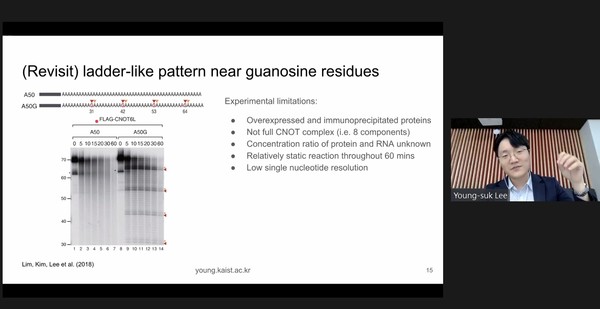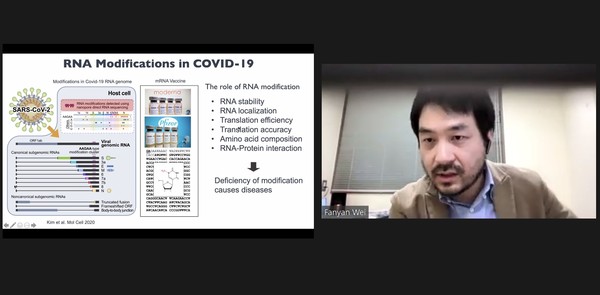Institute for Basic Science (IBS) Center for RNA Research and Seoul National University (SNU) School of Biological Sciences hosted an online meeting, ‘2021 IBS-SNU Mini-symposia on RNA Biology and Therapeutics,” on Wednesday.
RNA, or ribonucleic acids, are central components of genetic information in all life forms, even in viruses. A deeper understanding of RNA has shown mechanisms underlying complex biological functions with the recent developments of RNA therapeutics. To continue the ongoing effort for understanding RNA biology and therapeutics, scientists from various countries have joined the online meeting and shared topics from basic science to therapeutic applications.
Dr. Gunter Meister of the University of Regensberg, Germany, began his presentation with a novel ribonucleic acid (RNA) modification in mitochondrial tRNA and its function in regulating respiratory chain activity. "We think that the tRNA gets a very specific rigid conformation that would hinder the rotation of the ribosomal subunits and the shift of mRNA, and this is particularly important for one specific following nucleotide," Dr. Meister said.
Threonine tRNA is the only tRNA that changes expression level depending on the levels of Mettl8. The level goes up in the knockout while it goes down when researchers overexpressed Mettl8.
Dr. Meister pointed out that researchers have to see the effects of respiratory chain activity to increase modification of the particular tRNA, whether knockout leads to stalling specific codons for the tRNAs depending on the overexpression or knockout. He added that further studies are needed to look into structural analysis and show consistent results.

Professor Lee Young-suk at the Korea Advanced Institute of Science and Technology explained the deadenylation kinetics at single-nucleotide resolution in the meeting.
The study's objectives were to examine the mathematical model of deadenylation and experimental design and computational analysis.
Professor Lee's research team found that stalling only happened in the penultimate terminal position when used with experiments with AccR4 but mutant Cap1 and also saw the same with polyvinylpyrrolidone (PVP).
Lee said the study was to see the effects of stalling and how much the modification contributes to or inhibits the deadenylation process.
"What we think is that none-adenosine residues or the mixed tails what they do is regardless of the rate of deadenylation, whether it is passive or active, a mixed tailing effect significantly slows down the deadenylation process," Professor Lee said.
Based on the study, results suggest that deadenylation activity, if it is rapid, then the effect of the mixed tailing will be greater. But, at the same time, mixed tailing will probably not work too much in a passive activity.
Dr. Kim Hyun-joon at the Seoul National University joined the meeting and reported that the adenosine N6-methylation m6A demethylase FTO functions as a conserved regulator of motile ciliogenesis during embryonic development and airway epithelial homeostasis and inflammation.

Professor Fan-yan Wei at Tohoku University, Japan, introduced a study "Modified RNA signaling and its pathophysiological implications."
Professor Wei said, "The study results showed many nucleosides are generated as the consequence of RNA catabolism with the modifications being stably attached to the nucleosides, providing a framework for understanding the roles played by the complex pantheon of modified nucleosides."
The event organizers and participants had Q-and-Q sessions about the study results, and each participant had the Meet-the-Speaker session through their links.

